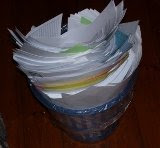By Marcia Francois, 2007

Remember a few years ago when we all got excited about a paperless society? Well, I don’t know about you but I seem to have more paper now than ever before.
But where does it all come from? Mail, magazines, newspapers, printed emails (I don’t do this but I know there are lots of you who do), birthday cards, takeaway menus, brochures, notes from school teachers, e-books, and the list goes on and on.
If you don’t have a system, you are going to get overwhelmed. And you know what happens when you become overwhelmed? You don’t do anything and things get worse.
Here are my steps to organise your paper:
1. Start by throwing away as much as possible
Paper should earn the right to be in your life. Don’t just hoard everything. Before you hit PRINT, ask yourself if you really need to print it.
Tip – if you’re in the habit of just printing everything, then put a post-it note on your computer to remind you to STOP AND THINK BEFORE PRINTING.
2. Decide what needs to be stored near and what can be stored further away
Items that you use on a daily basis should be stored near you while those you use less often should be kept further away.
My Household Organising File is literally at my fingertips while my old tax returns are filed at the back of my filing cabinet. See?
3. Determine your organising style
If you’re a visual person, you might need your accounts visible until you’ve paid them but if you like the minimalist look AND you will remember to pay it, you could file it away. If you work with your style instead of against it, you will be much happier and you’re more likely to keep up with the system.
I write the due date in my planner and file the account in a temporary place until paid, and then permanently file it. Until decluttering time, that is!
Tip – Go to http://www.letstalkorganizing.com/ebooks.html for a great resource on organizing your home office. I've read it and it is fabulous!
4. Decide on a home for each type of paper so you’ll know exactly where to find it later
You should have a system so that everybody in your family knows how to find any documents.
Magazines go in the lounge until the next one arrives, newspapers (once read) go in the recycling bag, children’s artwork goes in their scrapbook, all financial documents go in the study, etc.
5. Sort into categories – first broad and then narrow
File so that YOU can find it. It’s no use filing by name if you think by category.
For example, I remember by category, like coaching, organising, writing, etc. So I don’t have folders that say Jenny, Susan, Lisa. If I’m coaching Jenny, her emails go under coaching. Susan is a personal friend so her emails go under personal. Lisa and I are working on a joint venture so her emails go under… joint venture. That’s it :-)
6. Then do the actual filing
This can be fun if you play to your personality.
I like bright colours and nice, clear dividers and pretty files. It does help to have cute files so you're more likely to keep up your system. Let’s face it – would you rather file documents in boring, grey files that are falling apart or in lovely, colour-coded files? Of course you’d rather have the beautiful files.
Make sure you label clearly and keep your system simple. If you decide to change the categories, you don’t want to have to buy whole sets of stationery.
7. Maintain
This is the most important part of any organising project.
You have to set aside some time every week to get the paper under control.
Schedule 15 – 30 minutes every week for filing and throwing away newspapers, magazines and notes from school. If you run a business from home, I’d suggest that you schedule 15 minutes a day.
Remember the old saying, a stitch in time saves nine. This is so true for paper. Ignore the paper for a month and see how it takes you hours to sort out.
8. Control the clutter
If you are serious about getting a handle on the paper in your life, put some personal rules into place. For example, each child gets a clean pizza box for all their art every year. When that box is too full, they have to go through it and decide which to keep and which to toss.
I have a memory box for all love letters, birthday cards, anniversary cards, notes and so on. When it starts getting too full, I go through it and see what I can declutter. It’s amazing how each time you look though it (every couple of years), it is easier to decide on what’s most important to you at that point in your life.
As with everything else in life, it is always more work setting something up than maintaining it. It will probably take you a couple of hours to do steps 1 to 6, and then 15 minutes a week for steps 7 and 8.
You will save time by not looking for things and money on interest charges from missing invoices and by not buying duplicate items.
(C) Marcia Francois
Marcia Francois is a personal life coach and professional organiser who teaches busy people how to have more time, less stress and a more organised and fulfilled life. Visit http://takechargesolutions.org/ for your free Organise your Home e-book and other helpful tips.



No comments:
Post a Comment